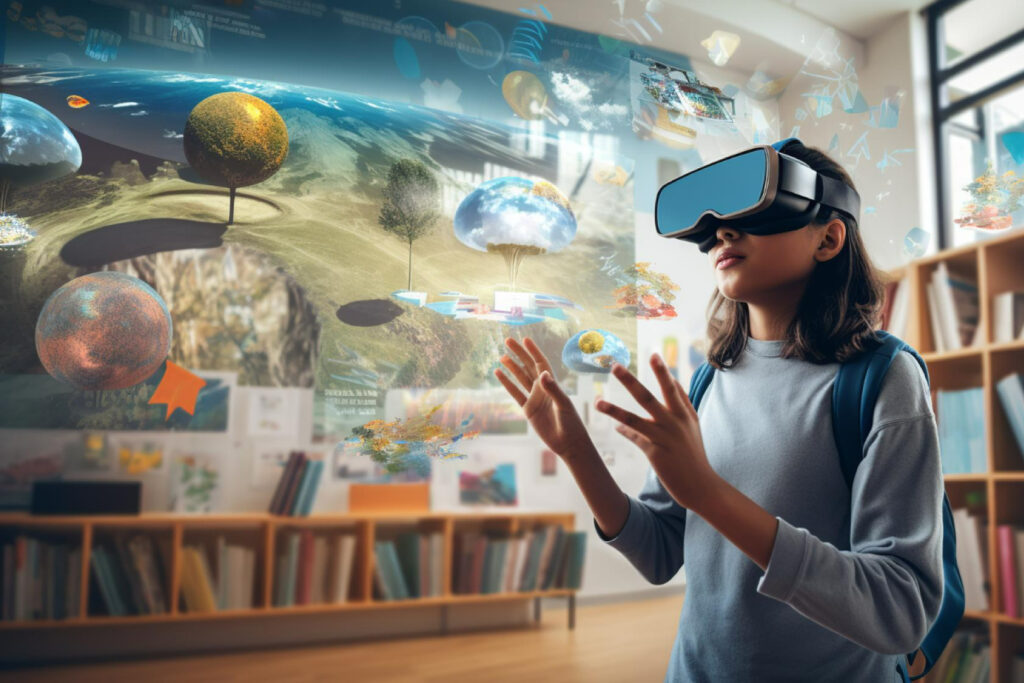
Introduction:
The use of augmented reality (AR) and virtual reality (VR) in education has opened up countless possibilities for immersive learning experiences at a time when technology is rapidly advancing. These tools, which provide students with an avenue to experience the world outside of textbooks, have transformed traditional classroom settings. They range from engaging virtual field trips to interactive simulations. The real potential of VR and AR, however, is found in promoting international student cooperation in addition to enhancing solitary learning. We examine the revolutionary possibilities of VR and AR in K–12 education in this blog article, as well as how they might act as catalysts for fruitful international cooperation.

Exploring the Landscape of VR and AR Tools:
Prior to exploring the world of international cooperation, let’s become acquainted with some of the major VR and AR resources that are changing the face of education. Websites such as Veative, Nearpod, and YouTube 360 films have become indispensable tools for teachers who want to use VR and AR in the classroom to create immersive learning environments. With the extensive collection of interactive simulations that Veative provides, students can interact practically with difficult ideas. With Nearpod, instructors can easily include virtual reality (VR) experiences into their class plans, enabling them to provide engaging presentations for their students. In the meanwhile, YouTube 360-degree films take students to far-off places, providing them with virtually limitless field trips.
Unlocking Global Collaborations:
Let’s now close the distance between international partnerships and immersive learning. Consider a classroom in New York using Veative’s lifelike virtual reality simulations to go on a virtual field trip to the Great Wall of China. Through the same virtual experience, students in Beijing, located halfway around the world, are likewise discovering the glories of their cultural heritage. Teachers can organize real-time collaborative sessions where students from several continents collaborate to solve interactive puzzles or dissect virtual specimens by using platforms such as Nearpod. Additionally, YouTube 360-degree films provide a global forum for students to share cultural experiences and exchange viewpoints and thoughts from around the globe.

Lesson Plan: Journey Across Continents
Objective:
To facilitate global collaborations and cultural exchange through immersive VR experiences.
Materials Needed:
– Veative VR headset or compatible VR devices
– Nearpod presentation with interactive VR content
– YouTube 360 videos showcasing cultural landmarks
– Internet-enabled devices for each student
Procedure:
1. Introduce the concept of global collaborations and the importance of cultural exchange in today’s interconnected world.
2. Divide students into groups, ensuring diversity in geographical backgrounds.
3. Provide each group with access to Veative VR headsets or compatible VR devices.
4. Guide students through a virtual field trip to a culturally significant landmark using Veative’s immersive simulations.
5. Encourage students to take notes and reflect on their experiences during the virtual journey.
6. Reconvene the class and facilitate a collaborative discussion using Nearpod’s interactive VR presentation.
7. Allow students to share their insights and observations, fostering dialogue across cultural boundaries.
8. Conclude the lesson with a screening of YouTube 360 videos showcasing various cultural landmarks, encouraging students to explore and appreciate the diversity of our world.
Conclusion:
Overall, the incorporation of virtual reality and augmented reality into educational settings presents significant opportunities for promoting cross-cultural cooperation and understanding among students. Through the utilization of immersive technology, instructors have the ability to surpass geographical limitations and offer students chances to investigate varied viewpoints and participate in significant cross-cultural interactions. Let’s take a collaborative step towards a future that is more compassionate and interconnected as we embrace the revolutionary potential of virtual reality and augmented reality in education.
